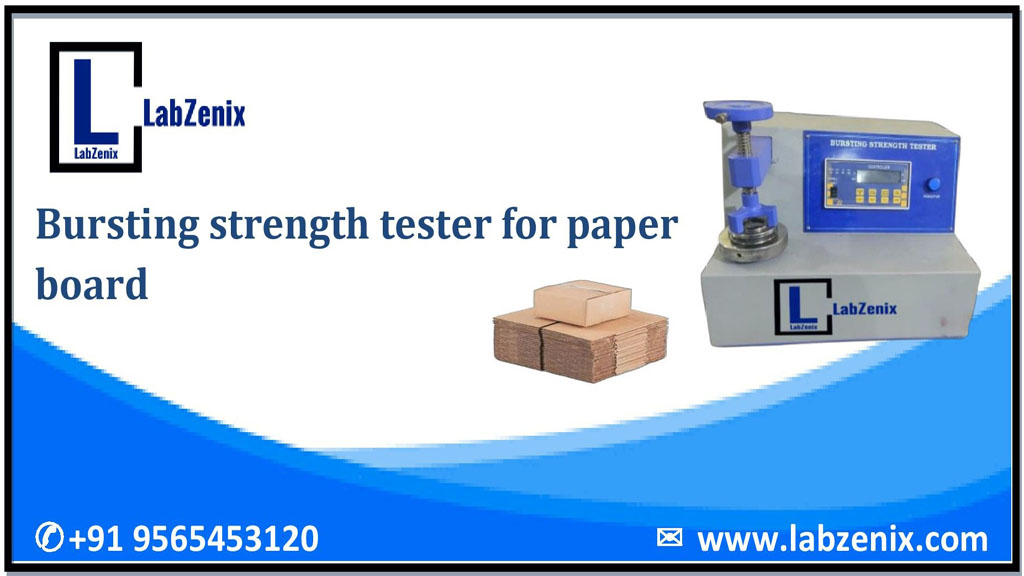Bursting strength tester for paper board
Bursting strength tester for paper board- LabZenix
An important testing equipment for the paperboard is the bursting strength tester. In fact, it is one of the test machines that have significant applications in the packaging and paper industries.
Description
Bursting Strength Tester for Paper Board – The Ultimate Guide
Introduction
An important testing equipment for the paperboard is the bursting strength tester. In fact, it is one of the test machines that have significant applications in the packaging and paper industries. It measures how much pressure paper, cardboard, and corrugated boards can withstand bullying before rupturing. This kind of testing is very important because packaging materials should withstand any external force applied during transportation and handling.
This extensive guide covers the need and working principle of a bursting strength tester for paper board along with its applications, standards, and key features. Professionals and researchers in various fields, from manufacturers to those in quality control, must understand this equipment to help them ensure products retain their durability with provisions of compliance.
What is a Bursting Strength Tester for Paper Board?
A bursting strength tester for paper board is a heavy-duty piece of equipment that performs tests to determine the different strengths of paper, cardboard, and other similar materials. It ruptures a predetermined area of the sample using hydraulic pressure and reports the maximum pressure (kPa or psi) at which that material was able to sustain itself.
Such tests are crucial to industries whose very life exists in the strength of their packaging: shipping, food packaging, e-commerce, to name just a few. A quality bursting strength testing machine for paper board guarantees conformance with ISO 2758, ASTM D3786, TAPPI T403, etc.
Why is Bursting Strength Testing Important?
Ensures Packaging Durability – Determines if boxes and cartons can protect goods during transit.
Quality Control – Helps manufacturers maintain consistent material strength.
Compliance with Standards – Ensures adherence to international testing norms.
Reduces Waste – Identifies weak materials before production, minimizing losses.
How Does a Bursting Strength Tester for Paper Board Work?
The bursting strength tester for paper board operates on a hydraulic mechanism. Here’s a step-by-step breakdown:
Sample Preparation – A circular paper or cardboard sample is clamped between two rings.
Pressure Application – A rubber diaphragm expands using hydraulic pressure, pressing against the sample.
Burst Detection – The machine records the pressure at which the sample ruptures.
Result Display – The bursting strength value is shown on a digital or analog display.
Key Features of a High-Quality Bursting Strength Tester for Paper Board
When selecting a bursting strength tester for paper board, consider these features:
Digital Display – Provides accurate and easy-to-read results.
Automatic Clamping – Ensures uniform pressure application.
High Precision – Delivers reliable and repeatable measurements.
Robust Construction – Made from durable materials for long-term use.
User-Friendly Interface – Simple controls for efficient operation.
Compliance with Standards – Meets ISO, ASTM, and TAPPI requirements.
Applications of Bursting Strength Tester for Paper Board
The bursting strength tester for paper board is widely used in:
Packaging Industry – Tests corrugated boxes, cartons, and shipping containers.
Paper Manufacturing – Evaluates the strength of different paper grades.
Quality Assurance Labs – Ensures materials meet customer specifications.
Research & Development – Helps in developing stronger packaging solutions.
Standards for Bursting Strength Testing
Several international standards govern bursting strength testing for paper board, including:
ISO 2758 – For paper and board bursting strength.
ASTM D3786 – Standard test method for hydraulic bursting strength of textiles.
TAPPI T403 – Bursting strength of paper.
JIS P8112 – Japanese Industrial Standard for bursting strength.
Factors Affecting Bursting Strength of Paper Board
Several factors influence the bursting strength of paper board:
Material Thickness – Thicker boards generally have higher bursting strength.
Fiber Quality – Long, strong fibers enhance durability.
Moisture Content – Excessive moisture weakens the material.
Manufacturing Process – Proper bonding and pressing improve strength.
FAQs About Bursting Strength Tester for Paper Board
1. What is the purpose of a bursting strength tester for paper board?
The bursting strength tester for paper board measures how much pressure a material can withstand before rupturing, ensuring packaging durability and quality.
2. Which industries use a bursting strength tester for paper board?
Industries like packaging, paper manufacturing, shipping, and e-commerce rely on this tester for quality assurance.
3. What are the key standards for bursting strength testing?
Common standards include ISO 2758, ASTM D3786, TAPPI T403, and JIS P8112.
4. How often should a bursting strength tester be calibrated?
Calibration should be done annually or as per the manufacturer’s guidelines to ensure accuracy.
5. Can a bursting strength tester be used for other materials?
Yes, some testers can evaluate textiles, leather, and plastic films, but the primary use is for paper and cardboard.
6. What is the difference between bursting strength and tensile strength?
Bursting strength measures resistance to rupture under pressure, while tensile strength evaluates resistance to pulling forces.
7. How do I maintain a bursting strength tester for paper board?
Regular cleaning, lubrication, and calibration ensure optimal performance and longevity.
8. What is the typical bursting strength range for corrugated boards?
It varies, but common ranges are between 200 kPa to 1000 kPa, depending on material quality.
9. Can humidity affect bursting strength test results?
Yes, high humidity can weaken paper and cardboard, leading to lower bursting strength values.
10. Is a digital bursting strength tester better than an analog one?
Digital testers offer higher precision, easier data recording, and better user experience compared to analog models.
Final Thoughts
The bursting strength tester for paper board is a critical tool for ensuring packaging integrity and compliance with industry standards. By investing in a high-quality tester, manufacturers can enhance product reliability, reduce waste, and meet customer expectations.
For more information on selecting the best bursting strength tester for paper board, consult industry experts or trusted suppliers like LabZenix.
Contact – LabZenix


Pingback: Bursting Strength Tester for Better Packing | LabZenix » LABZENIX TESTING INSTRUMENTS
Pingback: Bursting Strength Tester to Cut Product Loss » LABZENIX TESTING INSTRUMENTS
Pingback: Bursting Strength Tester That Meets Standards » LABZENIX TESTING INSTRUMENTS
Pingback: Why Brands Trust a Bursting Strength Tester » LABZENIX TESTING INSTRUMENTS